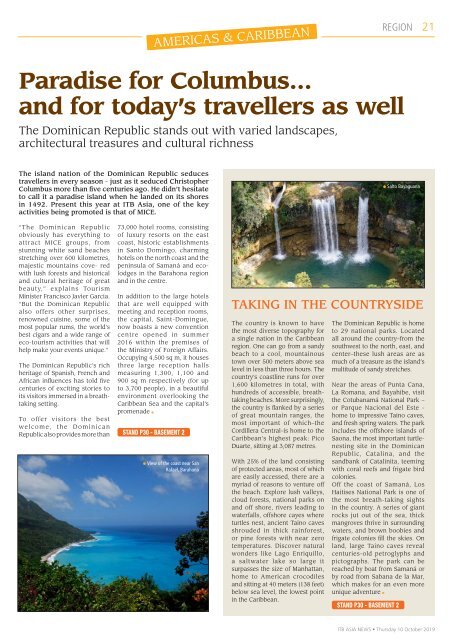ITB Asia News 2019 Preview Edition
You also want an ePaper? Increase the reach of your titles
YUMPU automatically turns print PDFs into web optimized ePapers that Google loves.
AMERICAS & CARIBBEAN<br />
REGION<br />
21<br />
Paradise for Columbus…<br />
and for today’s travellers as well<br />
The Dominican Republic stands out with varied landscapes,<br />
architectural treasures and cultural richness<br />
The island nation of the Dominican Republic seduces<br />
travellers in every season - just as it seduced Christopher<br />
Columbus more than five centuries ago. He didn’t hesitate<br />
to call it a paradise island when he landed on its shores<br />
in 1492. Present this year at <strong>ITB</strong> <strong>Asia</strong>, one of the key<br />
activities being promoted is that of MICE.<br />
Salto Bayaguana<br />
“The Dominican Republic<br />
obviously has everything to<br />
attract MICE groups, from<br />
stunning white sand beaches<br />
stretching over 600 kilometres,<br />
majestic mountains cove- red<br />
with lush forests and historical<br />
and cultural heritage of great<br />
beauty,” explains Tourism<br />
Minister Francisco Javier García.<br />
“But the Dominican Republic<br />
also offers other surprises,<br />
renowned cuisine, some of the<br />
most popular rums, the world’s<br />
best cigars and a wide range of<br />
eco-tourism activities that will<br />
help make your events unique.”<br />
The Dominican Republic’s rich<br />
heritage of Spanish, French and<br />
African influences has told five<br />
centuries of exciting stories to<br />
its visitors immersed in a breathtaking<br />
setting.<br />
To offer visitors the best<br />
welcome, the Dominican<br />
Republic also provides more than<br />
73,000 hotel rooms, consisting<br />
of luxury resorts on the east<br />
coast, historic establishments<br />
in Santo Domingo, charming<br />
hotels on the north coast and the<br />
peninsula of Samaná and ecolodges<br />
in the Barahona region<br />
and in the centre.<br />
In addition to the large hotels<br />
that are well equipped with<br />
meeting and reception rooms,<br />
the capital, Saint-Domingue,<br />
now boasts a new convention<br />
centre opened in summer<br />
2016 within the premises of<br />
the Ministry of Foreign Affairs.<br />
Occupying 4,500 sq m, it houses<br />
three large reception halls<br />
measuring 1,300, 1,100 and<br />
900 sq m respectively (for up<br />
to 3,700 people), in a beautiful<br />
environment overlooking the<br />
Caribbean Sea and the capital’s<br />
promenade<br />
STAND P30 - BASEMENT 2<br />
View of the coast near San<br />
Rafael, Barahona<br />
TAKING IN THE COUNTRYSIDE<br />
The country is known to have<br />
the most diverse topography for<br />
a single nation in the Caribbean<br />
region. One can go from a sandy<br />
beach to a cool, mountainous<br />
town over 500 meters above sea<br />
level in less than three hours. The<br />
country’s coastline runs for over<br />
1,600 kilometres in total, with<br />
hundreds of accessible, breathtaking<br />
beaches. More surprisingly,<br />
the country is flanked by a series<br />
of great mountain ranges, the<br />
most important of which–the<br />
Cordillera Central–is home to the<br />
Caribbean’s highest peak: Pico<br />
Duarte, sitting at 3,087 metres.<br />
With 25% of the land consisting<br />
of protected areas, most of which<br />
are easily accessed, there are a<br />
myriad of reasons to venture off<br />
the beach. Explore lush valleys,<br />
cloud forests, national parks on<br />
and off shore, rivers leading to<br />
waterfalls, offshore cayes where<br />
turtles nest, ancient Taino caves<br />
shrouded in thick rainforest,<br />
or pine forests with near zero<br />
temperatures. Discover natural<br />
wonders like Lago Enriquillo,<br />
a saltwater lake so large it<br />
surpasses the size of Manhattan,<br />
home to American crocodiles<br />
and sitting at 40 meters (138 feet)<br />
below sea level, the lowest point<br />
in the Caribbean.<br />
The Dominican Republic is home<br />
to 29 national parks. Located<br />
all around the country–from the<br />
southwest to the north, east, and<br />
center–these lush areas are as<br />
much of a treasure as the island’s<br />
multitude of sandy stretches.<br />
Near the areas of Punta Cana,<br />
La Romana, and Bayahibe, visit<br />
the Cotubanamá National Park –<br />
or Parque Nacional del Este -<br />
home to impressive Taino caves,<br />
and fresh spring waters. The park<br />
includes the offshore islands of<br />
Saona, the most important turtlenesting<br />
site in the Dominican<br />
Republic, Catalina, and the<br />
sandbank of Catalinita, teeming<br />
with coral reefs and frigate bird<br />
colonies.<br />
Off the coast of Samaná, Los<br />
Haitises National Park is one of<br />
the most breath-taking sights<br />
in the country. A series of giant<br />
rocks jut out of the sea, thick<br />
mangroves thrive in surrounding<br />
waters, and brown boobies and<br />
frigate colonies fill the skies. On<br />
land, large Taino caves reveal<br />
centuries-old petroglyphs and<br />
pictographs. The park can be<br />
reached by boat from Samaná or<br />
by road from Sabana de la Mar,<br />
which makes for an even more<br />
unique adventure<br />
STAND P30 - BASEMENT 2<br />
<strong>ITB</strong> ASIA NEWS • Thursday 10 October <strong>2019</strong>

















